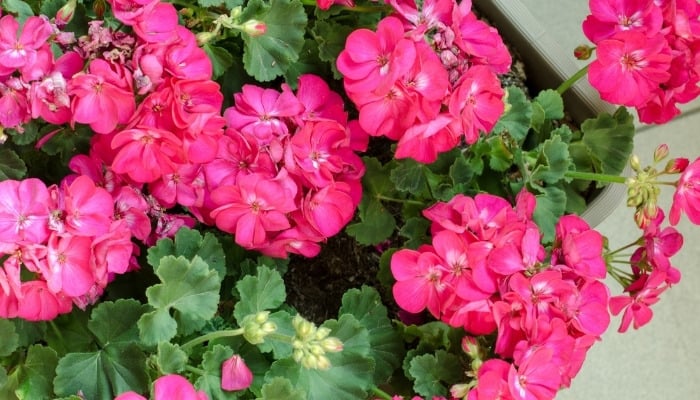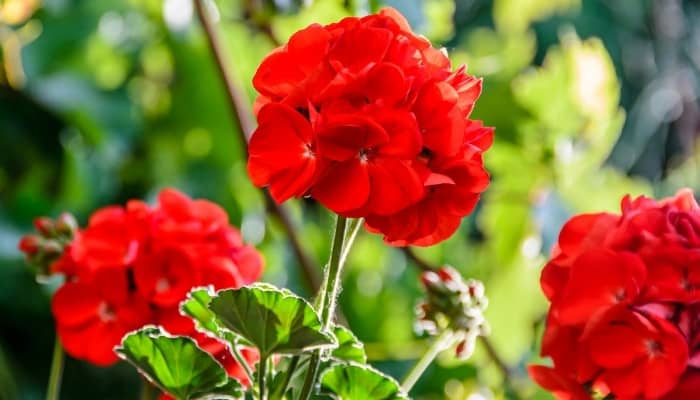Geraniums have long been a dependable and beloved plant among dedicated gardeners, serving as a reliable choice for containers, borders, and beds for many years. But rest assured, there is much more to these flowering plants than meets the eye.
They provide a boost of purple, red, orange, pink, or white color to an outside space, love hot weather, manage to thrive in dry conditions, and can be overwintered easily.
They are rarely attacked by insects or pests, and they have bright, showy blooms ready to be the centerpiece of any garden.
Geraniums are the sweetheart of the garden flower world, and if you’ve ever fallen in love with geraniums, you’ll want them to bloom perpetually – and that’s what this overview is all about!
Below, we cover the 12 secrets to geranium-blooming success.
1. Remove Spent Flowers Regularly
One thing about flowering geraniums is that you have to remove the flowers from time to time. Once your geraniums bloom, it’s time to start deadheading (this is the process of removing old flowers) them.
This small task alone is a major factor in keeping your geraniums blooming.
If you leave the old blooms in place, the plant will keep wasting energy on trying to power dead flowers when it could be using that energy to create new beautiful blooms that last longer.
When removing spent flowers, don’t just remove the flower head. Instead, cut the entire bloom stem right down to the base of the plant.
2. Fertilize
Geraniums are not heavy feeders, but even so, they do like a good dose of all-purpose fertilizer.
This is especially the case if you’re growing geraniums in baskets and containers because the soil has limited access to nutrients.
Don’t bombard your plants with a heavy dose. Rather use a light dose of all-purpose liquid fertilizer that you can apply every 21 to 28 days.
You must keep the dose light, so only mix half the recommended quantity. Both Miracle-Gro and Schultz are great for geraniums.
3. Provide Plenty of Light
Geraniums are sun worshippers and will reward you with beautiful blooms if you provide them with plenty of sunlight.
For beautiful blooms for longer, expose your geraniums to five to six hours of direct sunlight per day, and 12 hours of daylight.
4. Cut Back Leggy Growth
If you leave your geraniums to grow at will, they will eventually become leggy and sparse – and this is more so the case with geraniums grown in pots and containers.
When the soil space is limited, plants start to grow outwards quickly and thus get that leggy look. To stop this from happening, pinch back the stem to encourage thicker, denser growth.
Start pinching stems back in early spring. Multiple shoots will start developing from pruned stems, and this can lead to many more blooms and beautiful flowers.
5. Water Consistently
Geraniums that get too much or too little water start to stress, and stressed geraniums don’t produce a large amount of beautiful blooms.
Geraniums in baskets and containers will need more frequent watering than in-ground plants.
While providing a consistent water supply, it’s best to note that geraniums don’t like wet feet, so never allow the plant to live in soggy soil. Allow the soil to dry out between watering.
Before watering, push your finger into the soil around 1 to 2 inches deep. If the soil feels dry, water deeply. If it’s not dry, it’s not the right time to water the plant.
6. Remove Dying Leaves
If your geranium has yellow or withering leaves, it is a good idea to trim them off promptly.
This ensures that the plant is not stressed trying to provide nutrition to a part of itself that is no longer functioning as required.
Use a pair of sharp pruners to trim back dead and dying leaves and dispose of them.
7. Make Sure Soil Is High Quality, Rich & Fresh
While some plants love a dose of high-end fertilizer and fancy soil, geraniums don’t. They just need the simple basics in order to thrive.
Providing the ideal soil will ensure that your geraniums are happy and blooming. Give your geraniums loose soil that’s packed with plenty of organic matter.
If you have heavy soil, mix in some peat, perlite, or compost. It’s not recommended to use manure or vermiculite with geraniums.

8. Make Sure Soil Drains Well
Both potted and outside in-ground geraniums require soil that is moist and drains quickly. Add equal amounts of soil, peat, and perlite to your containers to provide a good well-draining soil.
Geraniums demand good drainage, and while you can provide this with the right soil mix, you can use drainage holes to ensure that the soil remains moist but not soggy.
9. Maintain Ideal Temperatures
You will find that geraniums can survive in temperatures that range from 45℉ to 80℉.
That said, they do their best blooming when they are in warm temperatures, so try to maintain temperatures closer to 80℉s.
If the temperatures drop below 40℉, it is best to move the containers inside or cover the plants in plastic to provide some protection at night.
10. Repot When Needed
Most people think that geraniums are just like other plants and won’t like being a little rootbound. The thing about geraniums is that they bloom best when they are slightly rootbound.
Repotting is sometimes necessary if your plant is overgrown and the soil lacks nutritional value, but don’t go bigger than 1 to 2 inches at a time.
Alternatively, just remove old soil, provide new, fresh soil, and go on as normal. It’s best to repot geraniums in spring.
Gardening tip: Repotting is a terrific opportunity to divide your geranium and multiply your collection!
11. Check Routinely for Pests and Diseases – Treat Promptly
Interestingly, geraniums are more prone to pests and diseases when grown indoors. The pests likely to attack geraniums include whiteflies, aphids, and mites.
It is best to do weekly checks to ensure that your plant hasn’t fallen victim to these.
You can also mix a weak solution of dishwashing liquid and water and give the plants a gentle misting with it (you will need a spray bottle for this).
You may find it interesting that geraniums can repel mosquitoes, leafhoppers, and several other insects.
12. Mulch To Retain Moisture
Heavy mulch with a slow breakdown is great to use between geraniums to keep weeds at bay and stabilize the soil by adding body to it.
Mulch will also minimize water splashing up on the plants that can cause fungal problems on the leaves.
Even container-grown geraniums will benefit from a light layer of mulch. It will help to slow evaporation.
Conclusion
These 12 simple steps are the secrets to ensuring that your geraniums don’t just flourish but absolutely thrive and bloom for the entire season and beyond.
Nothing can quite compare to the scene of a beautiful outdoor space accented with the pop of color that only geraniums can achieve.
Try each step above and see how your geraniums truly shine!

